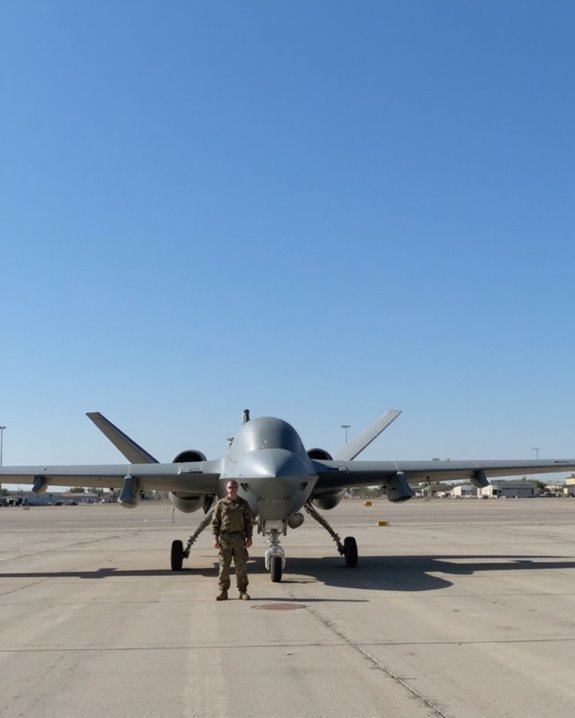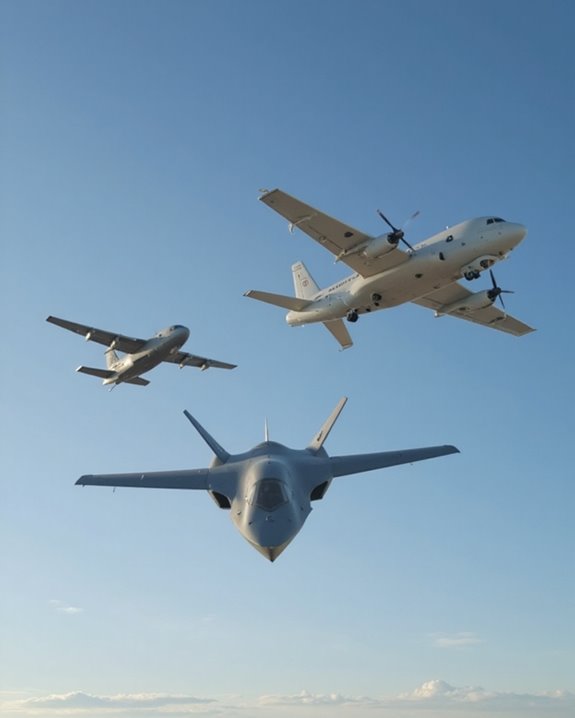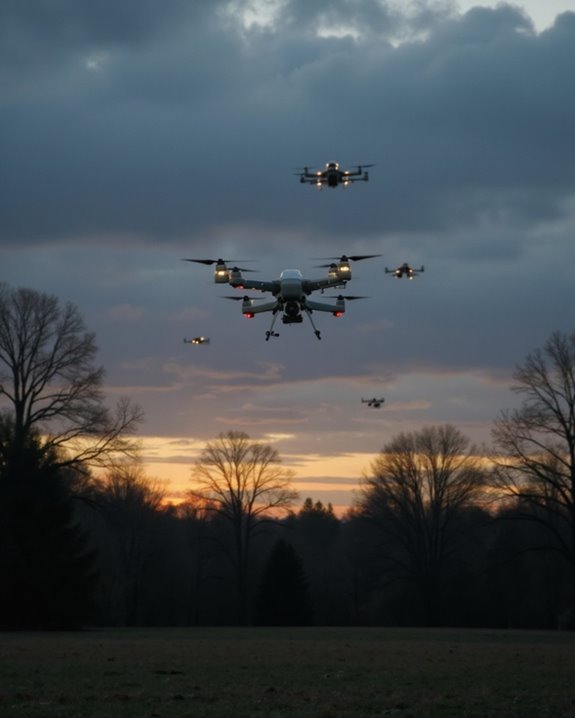Military drones come in astonishing size varieties! The tiny Black Hornet 3 weighs just 33 grams, while the massive RQ-4 Global Hawk boasts a 130-foot wingspan. Nano drones excel at stealth operations, medium-sized models like the MQ-1B Predator (27-foot fuselage) can fly for 36 hours, and large platforms like the MQ-9 Reaper carry 1,700+ pound payloads. A drone’s dimensions directly impact its mission capabilities, range, and battlefield effectiveness. The complete size spectrum reveals fascinating operational differences.
Key Takeaways
- Military drones range from tiny 33-gram nano drones like Black Hornet 3 to massive platforms like Global Hawk with 130-foot wingspans.
- Smaller drones excel in stealth and portability, while larger drones offer extended flight times exceeding 40 hours.
- Medium-sized drones like the MQ-1B Predator balance payload capacity and endurance with wingspans of 5-16.8 meters.
- Size directly impacts mission capabilities, with larger drones carrying multiple sensors and weapons up to 450 kg.
- Deployment requirements vary significantly, from hand-launched mini drones to large platforms requiring dedicated airfields and infrastructure.
Comparing Nano and Small Military Drone Dimensions
The remarkable world of military drones spans an impressive range of sizes, with nano and small drones representing two distinct categories that serve unique tactical purposes. When conducting Dimensional Analysis, the differences are striking! Nano drones like the Black Hornet 3 weigh just 33 grams and measure a mere 169 mm in length—small enough to fit in your pocket.
In sharp contrast, small drones occupy the middle ground in the Comparative Sizes spectrum, measuring between 50 cm and 2 meters long. While both classifications offer impressive portability, nano drones excel at stealth operations due to their tiny footprint, while small drones provide greater versatility and payload capacity. The size difference directly impacts their detectability too—try spotting a hummingbird-sized drone from 100 meters away! The RQ-11 Raven UAV, for instance, features exceptional portability with its 4.5-foot wingspan and lightweight design, making it ideal for military backpack transport.
Medium-Sized Military Drones: The Middle Ground
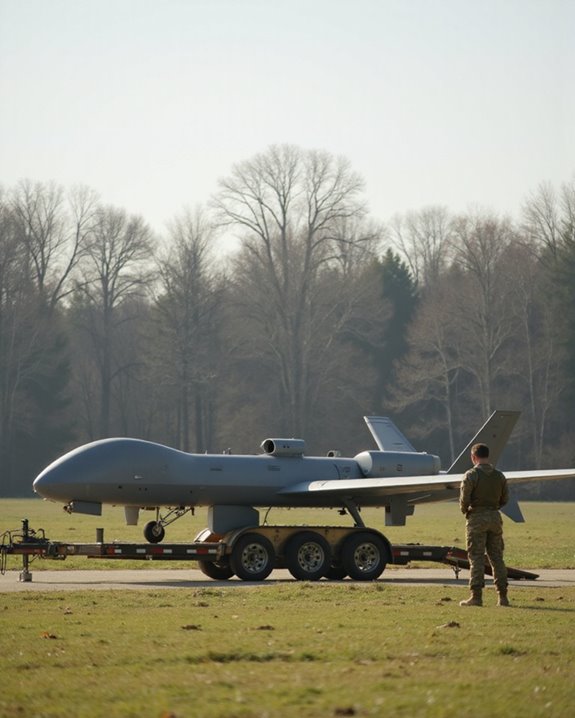
Moving up the size chart from nano and small drones, medium-sized military drones occupy an impressive sweet spot in the UAV ecosystem, balancing impressive capabilities with manageable dimensions. These versatile platforms typically exceed 2 meters in length with wingspans ranging from 5 to 16.8 meters—quite the growth from their tiny cousins! The Historical Evolution of medium drones like the MQ-1B Predator has revolutionized battlefield awareness with endurance stretching to 36 hours.
With payload capacities between 200-450 kg, these workhorses can carry everything from advanced sensors to Hellfire missiles while reaching altitudes up to 30,000 feet. Future Innovations in medium drone technology will likely focus on enhancing their already impressive blend of range, endurance, and strike capabilities—making them even more indispensable for military operations worldwide! Modern tactical drones increasingly incorporate advanced stabilization systems to ensure steady footage during critical maneuvers.
Large Military Drones: Features and Proportions
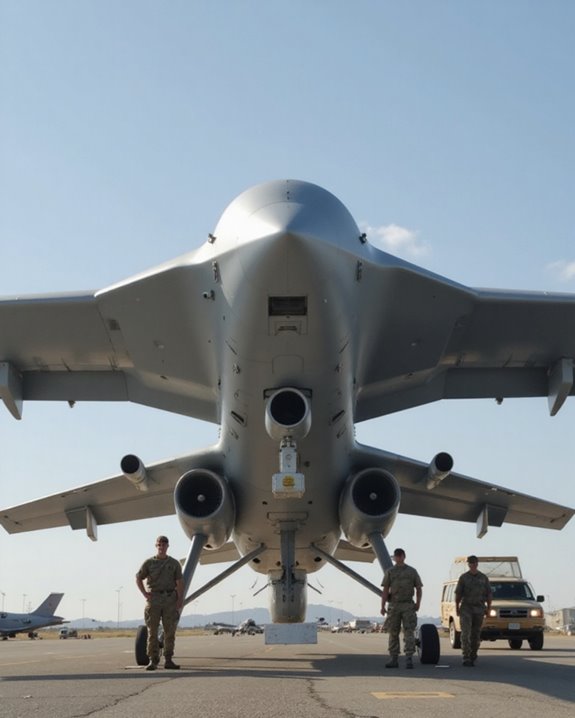
Entering the domain of large military drones reveals truly impressive machines that dwarf their smaller counterparts in both size and capability. Take the RQ-4 Global Hawk with its massive 130-foot wingspan—that’s wider than many commercial airliners! The MQ-9 Reaper, while smaller at 66 feet across, still commands respect on any runway.
These aerial giants showcase remarkable Durability Features, with robust airframes designed to carry significant payloads while withstanding harsh conditions. Their Propulsion Efficiency is equally impressive, with powerplants like the Reaper’s 900-horsepower Honeywell turboprop engine that sips fuel efficiently during those marathon missions. Would you believe these behemoths can stay airborne for over 1,000 nautical miles? Talk about having serious staying power in the skies!
Many large drones also feature advanced safety elements such as GPS-assisted navigation and interference prevention systems to ensure mission success.
The MQ-1 Predator: Size Specifications and Payload Capacity
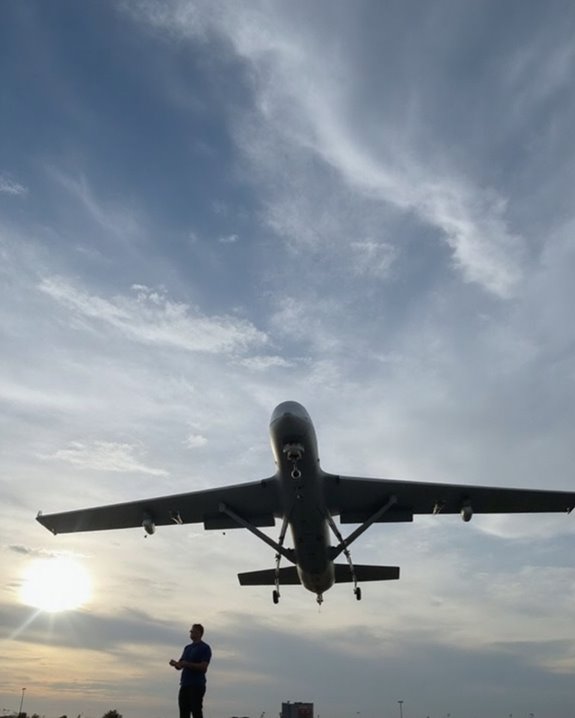
Among the most iconic military drones ever deployed, the MQ-1 Predator strikes an impressive silhouette with its distinctive 27-foot fuselage and remarkable 55-foot wingspan—longer than a city bus! Standing just 7 feet tall, this relatively compact drone packs impressive capabilities into its modest frame.
The Physical Dimensions belie the Predator’s operational punch. While its empty weight is merely 1,130 pounds (about the same as a grand piano!), it can take off with a maximum weight of 2,250 pounds. This gives the aircraft a substantial Load Capacity of approximately 450 pounds for sensors and weaponry, typically including two Hellfire missiles for precision strikes. Despite its slender profile, the Predator can reach altitudes of 25,000 feet and loiter over targets for an impressive 14 hours.
MQ-9 Reaper: Wingspan and Weight Classifications
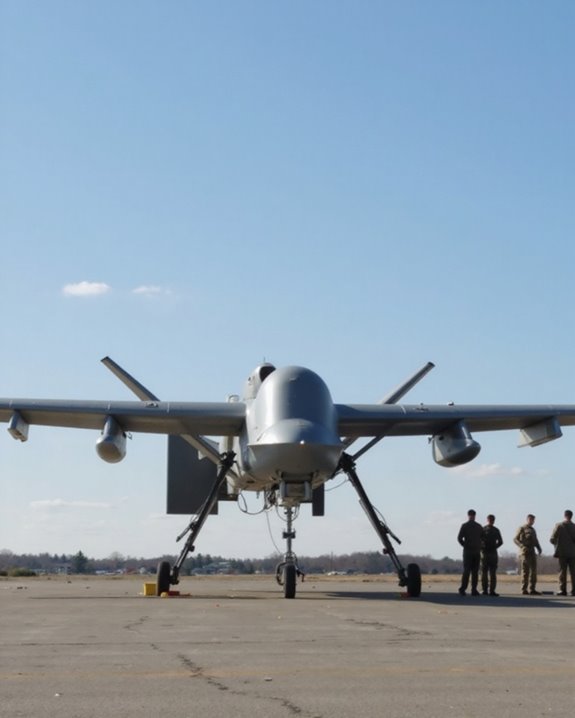
The MQ-9 Reaper represents a substantial leap forward in military drone technology, dwarfing its Predator predecessor with impressive physical dimensions. This aerial giant boasts a massive 66-foot wingspan, roughly the length of a tennis court! The Wingspan Evolution from earlier models demonstrates how far drone technology has advanced, creating a more stable platform for extended missions.
Weight Optimization plays a vital role in the Reaper’s design, balancing structural integrity with operational capability. With an empty weight of 4,900 pounds but a maximum takeoff weight reaching 10,500 pounds, the Reaper can carry more than twice its base weight in fuel and payloads. This remarkable engineering feat allows it to transport nearly 3,800 pounds of weapons and sensors while maintaining its impressive 30-hour endurance capabilities.
RQ-170 Sentinel: Stealth Design and Dimensional Aspects
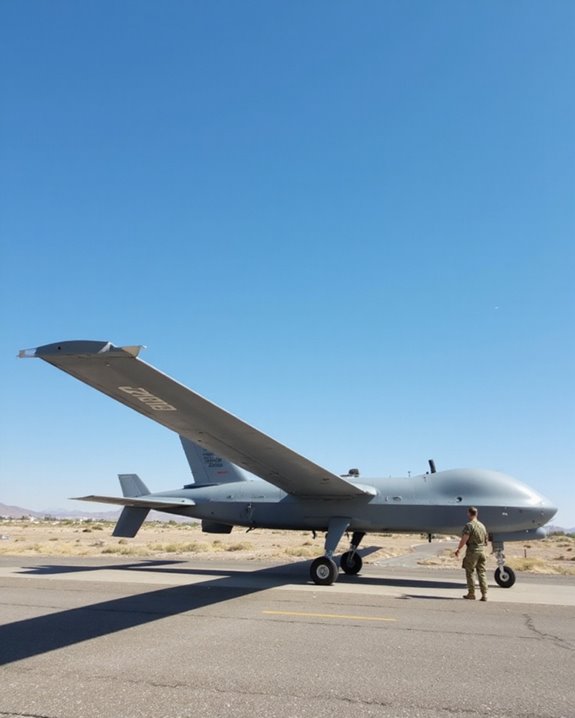
Moving from the massive Reaper to a more mysterious aircraft in the military drone arsenal, we encounter the enigmatic RQ-170 Sentinel, often referred to as the “Beast of Kandahar” by aviation enthusiasts.
The Sentinel’s dimensions remain somewhat elusive, with wingspan estimates varying dramatically from 38 to 65 feet—quite the range for such a classified aircraft! Its tailless flying wing design, combined with advanced Stealth Materials (approximately 90% composites), creates an extraordinary platform for Radar Evasion. While smaller than the Reaper, don’t let its compact frame fool you! The RQ-170 packs sophisticated surveillance technology into its roughly 15-foot length. Its low-observable technology makes this drone particularly suited for sensitive reconnaissance near borders of countries like Iran and China, where staying undetected is mission-critical. Talk about hiding in plain sight!
How Drone Size Affects Mission Capabilities and Deployment
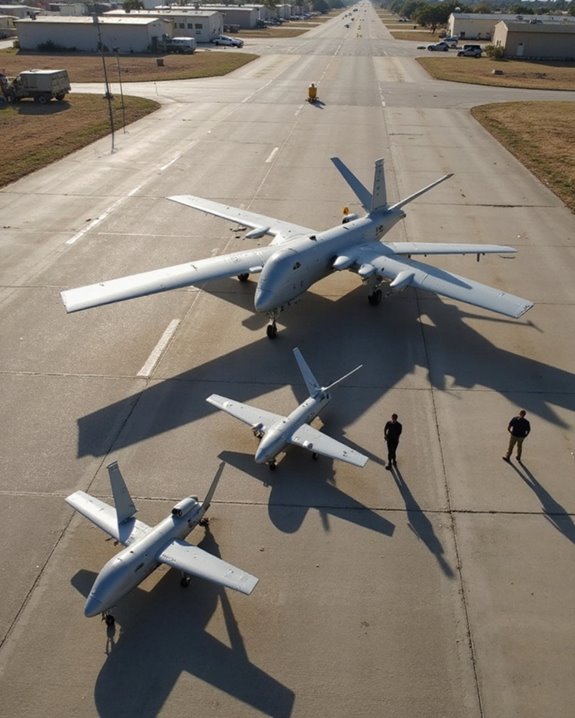
Size dramatically influences a military drone’s operational potential, creating distinct capabilities across the spectrum from pocket-sized reconnaissance units to massive strategic platforms! Smaller drones under 20 pounds zip around at low altitudes, perfect for quick scouting missions but with limited flight times. Those pesky endurance impacts mean operators must constantly juggle mission priorities against battery life!
Medium-sized systems (21-55 pounds) strike a balance between portability and capability, extending mission range while introducing moderate logistics challenges. The real heavy-hitters—those 1,320+ pound behemoths—deliver impressive 40+ hour endurance and can carry multiple payload types simultaneously, from advanced sensors to missiles. But don’t be fooled by their capabilities; these larger platforms demand proper airfields, maintenance crews, and substantial support infrastructure to keep them flying!
Frequently Asked Questions
How Do Drone Sizes Affect Their Vulnerability to Anti-Drone Countermeasures?
Smaller drones minimize detection vulnerability through reduced radar cross-sections and acoustic signatures. Larger drones become easier targets for countermeasures, while their smaller counterparts excel at evasion tactics through agility and autonomous navigation capabilities.
What Materials Are Used to Reduce Weight While Maintaining Strength?
Material innovations in drone construction focus on carbon fiber composites, titanium and aluminum alloys, and magnesium components. These alloy composites deliver maximum strength-to-weight ratios, enabling extended flight times and improved payload capacity.
How Do Weather Conditions Impact Different Drone Size Categories?
Weather conditions impact drones differently by size. Smaller drones experience greater wind effects, while larger platforms offer superior temperature resilience. Medium-sized drones balance these factors but remain vulnerable to heavy precipitation and extreme conditions.
Do Military Drones Use Size Camouflage Techniques for Mission Advantages?
Over 75% of tactical military drones employ Size Deception techniques to gain operational advantages. These include Visual Masking through miniaturization, adjustable profiles, and environmental mimicry that makes detection substantially more difficult for adversaries.
What Training Requirements Differ When Operating Various Sized Military Drones?
Training levels intensify as drone size increases, with micro drones requiring basic operational knowledge while larger drones demand thorough systems understanding. Certification processes become more rigorous, reflecting greater complexity and potential mission impact with increased size.

